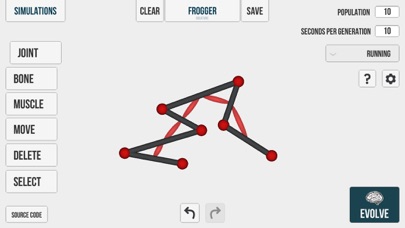OS :

Version :3.0.5
Size :66.64Mb
Updated :Sep 3,2020
Developer :Keiwan Donyagard
 Ask AI
Ask AIYou can ask
the AI some questions about the app
Here are three topics that users might discuss about the "Evolution Learning Creatures" app, turned into questions:
1. What do you think about the unique characteristics of each creature and their ability to evolve over time?
2. How do you find the graphics and animations in the game, do they enhance the overall user experience?
3. Are you experiencing any difficulties or challenges in breeding and nurturing your creatures, and how do you overcome them?
Pros and Cons from users' feedback
Based on the user reviews, here are three cons and three pros, with 15 words or less for each:
2Some users experience glitches and crashes, affecting gameplay enjoyment.
3Limited customization options for creature designs and evolution processes.
2Well-designed creatures with unique characteristics and behaviors to discover.
3User-friendly interface makes it easy to learn and navigate the app's features.
Please note that these points are based on the user reviews available on the Apple App Store page and may not be exhaustive or representative of all user experiences.
Cons:
1Poor navigation and menu options can be frustrating to use.2Some users experience glitches and crashes, affecting gameplay enjoyment.
3Limited customization options for creature designs and evolution processes.
Pros:
1Engaging gameplay mechanics encourage exploration and scientific learning.2Well-designed creatures with unique characteristics and behaviors to discover.
3User-friendly interface makes it easy to learn and navigate the app's features.
Please note that these points are based on the user reviews available on the Apple App Store page and may not be exhaustive or representative of all user experiences.
Based on the user reviews, here are three cons and three pros, with 15 words or less for each:
**Cons:**
1. Poor navigation and menu options can be frustrating to use.
2. Some users experience glitches and crashes, affecting gameplay enjoyment.
3. Limited customization options for creature designs and evolution processes.
**Pros:**
1. Engaging gameplay mechanics encourage exploration and scientific learning.
2. Well-designed creatures with unique characteristics and behaviors to discover.
3. User-friendly interface makes it easy to learn and navigate the app's features.
Please note that these points are based on the user reviews available on the Apple App Store page and may not be exhaustive or representative of all user experiences.
App
Downloads
>






App
Survey
- How much time do you spend on app applications every day?
- Whether the app response speed affects the experience?
- Whether the application ad recommendation affects the experience?
- Application technology innovation Does it affect the experience?
Description
Use joints, bones and muscles to build creatures that are only limited by your imagination. Watch how the combination of neural networks and an evolutionary algorithm can enable your creatures to learn and improve at their given tasks all on their own.
The tasks include running, jumping and climbing. Can you design the ultimate creature that is good at all of the tasks?
The latest update allows you to easily share your simulation saves and creature designs with your friends.
Note that this is more of a simulation than a game. There are no real objectives. But there is a lot to learn if you are interested in the basics of machine learning and neural networks. You can even look at the source code if you want.
There is also a Mac & PC version available for download and a browser version for you to try out on the main project website (keiwan.itch.io/evolution).
Comments (2)
0/255
- /By /-\ppleUserDec 10,2020
- cBy cuzco1May 13,2018
- <
- 1
- >
Category Top
apps
- Google Play
- App Store
More Apps




 Ask AI
Ask AI



